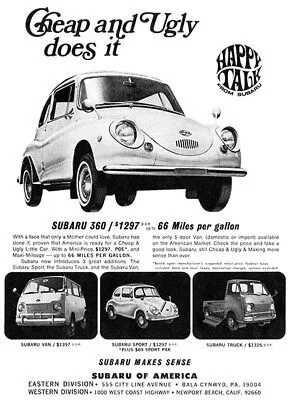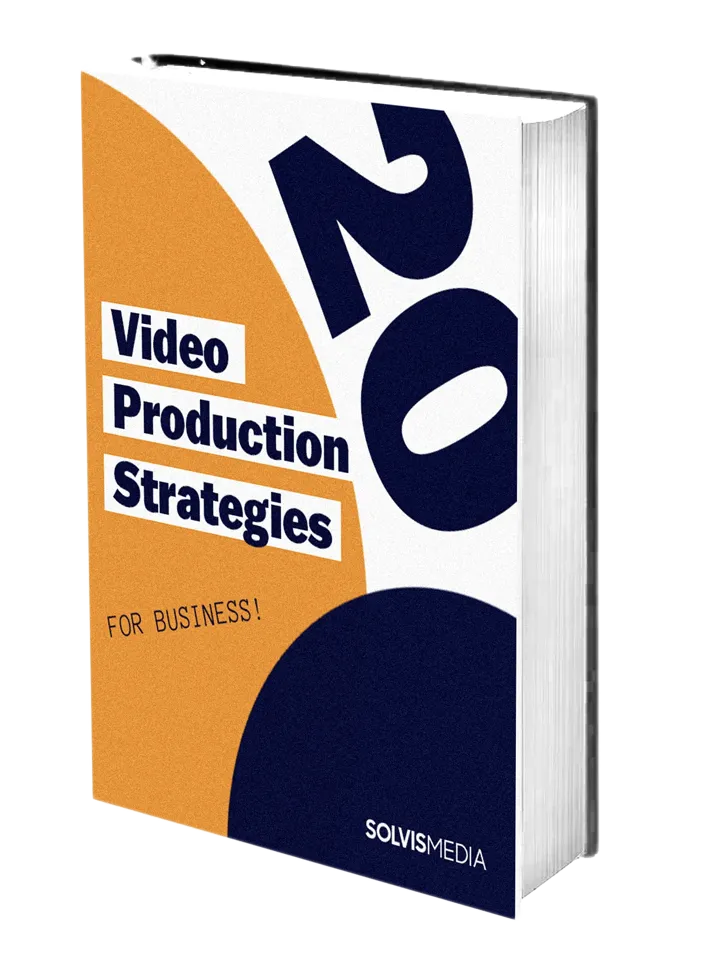Why Subaru?
In their advertising, Subaru doesn’t focus on customers they don’t have. They just focus on the customers that love the car. And I think that’s really paid off for them over the long term.
I think you’re going to get a lot out of this article, because Subaru has really mastered marketing to its existing customers better than any other car company.
The year is 1968. The first ad for this, David, in an Industry of Goliath’s hits American television for the first time. The advertisement explicitly calls their cars cheap and ugly.
Noted an unlikely success story by many today, the ad campaign then was paired with a car that suffered from poor sales and a lack of a market fit. While unremarkable in history, this short commercial is symbolic of a self-aware, consistent, and increasingly popular car manufacturer, and that car manufacturer is Subaru.
So, timeline-wise, I’m going to be talking a lot about 2004 to today.
I compartmentalize Subaru’s corporate timeline (in America at least) into two specific segments, which is the 70s to the 90s, where they were figuring out their market fit and who their customers were, and what their products were going to be, and then the second segment would be early 2000 to today.
Market Share Growth
In terms of market share growth from 1.56% in 2005, to 4.6% last year. That’s a jump from selling 276,000 cars in 2005, which is when they started tracking, to 632,020 in 2023.
632,000 from 276,000.
Their marketing since 2004 really has not changed a bit. And in fact, you could most likely take one of their old advertisements that they did back in, let’s say, 2005 or 2006, swap the cars out, keep the same messaging and run it today.
A lot of products are influenced by their customers. For example, their recent vehicle lineup, all the new cars now in the back, the back trunk have, a little spot where you could put, dog bowls for dog water.
All of their materials, all of their marketing materials are very wilderness-influenced. In fact, all of a lot of their products have a wilderness trim level on, on their car, which has, like, tow hooks and more aggressive styling.
It all goes along with a quote that the chief operating officer said in 2015 to the boardroom, telling executives to “Stop crowing about horsepower and prices.” And he said, “Start talking about the love customers have for their cars. Talk about their kids, talk about their kayaks, talk about the dogs, talk about their communities.”
They’ve been very steady in doing that over the course of the last 20 years. But I think that’s a great quote. When they first launched the love campaign they had, instead of doing a big Super Bowl ad, they decided to sponsor the Puppy Bowl.

Caring more about what the product does for the customer, rather than the product itself
There’s a lot of stuff to love about Subaru’s marketing.
When I close my eyes and think of the brand, I think of the car traveling through the redwood forests of the Pacific Northwest or, you know, some sort of small rock climb. You know, people who are very active and adventurous and that type of stuff. They also all happen to have golden retrievers, or ‘golden retriever energy’ in modern terms. So, they did the dog tested ads, which are great and shows that the car is durable.
My main point here, is that they clearly care more about what the car does for the customer rather than the car itself.
It’s the self-awareness that they kind of lean into, because the car itself is a very practical vehicle. There’s nothing very showy about a Subaru, but it’ll get you to where you want to go.
That’s why I started with that first ad, the cheap and ugly ad that they did. Because at the end of the day, the messaging behind that was, ‘yeah, it’s not a Volkswagen Beetle, but it will get you to where you need to go.’
And I thought that that was kind of cool to start with. If you look at their imagery, go on their website, go on their social media, every single post is a car out in nature or some sort of national park.
Mise en Scene
In the video production world, there’s something called, mise en scene, which essentially means, ‘what’s going on in the background.’
A great example:
If you’re sitting at a desk, the mise en scene could be:
- If there’s a lot of clutter on the desk, it represents the fact that this person is very messy.
- If the desk is very clean, it represents that the character is very clean.
With Subaru, what they do is they just pretty much take all of their pictures out in the wilderness. Have a look at their current instagram feed:

It’s a very subtle thing, but it’s really awesome when used properly.
My favorite ads
So, let’s get into the love campaign and some of the ads that they’ve done that I really like, they focused a lot on safety and reliability. They reinforced their reputation for building safe and reliable vehicles.
Some of the ads that I love are the father daughter, father son, moving out type ads.
It’s a dad that feels comfortable with his daughter buying a Subaru. It also symbolizes this idea in the parents’ minds that, those are still ‘kids’ at the end of the day, there’s still those same five, six year old kids. And, it’s really important to get them into a safe car. So Subaru did a great job of making this kind of emotional connection.
They did other ads where they highlighted personal stories and experiences of real Subaru owners, emphasizing these values of safety, reliability, and adventure.
They also talk a lot about their involvement in community services and, and charitable activities. They have that share the love event where some of their vehicle sales are donated to various charities.
This ad is called ‘Well Adventured.’ (Unfortunately not available on YouTube)
It’s a great ad. They do a lot of simple but very effective advertising. Some of my favorite pieces of work here, it’s just they kind of let the car speak for itself.
I can vividly remember ads that talked about how a lot of the Subarus that were sold ten years ago, 15 years ago are still on the road today. These are kind of the core value adds here that you’re hitting – all wheel drive, safety on the road, adventure, reliability, all that type of stuff.
There’s not a lot of sizzle there, but it’s something to keep in mind that a lot of their imagery is very centered around who already loves the car, who already buys the car.
Because they’ve leaned into their market and not tried to capture anybody else, they’ve actually sold a lot more cars. It was this slow burn for them. They slowly crept up to five, almost 5% of the market share, which is really incredible in America for such a small, what we would consider a smaller car brand.
Applying this to our brands
So how do we apply this to our brands?
Sometimes we forget about this as marketers, as business owners, we forget the best customers we can get are the ones that already exist. You know, we’re very concerned with gaining new ground that sometimes we forget about the people who already love our products and already love our services and already love the brand.
Subaru doesn’t really focus on customers they don’t have. They just focus on the customers that love the car in their advertising. And I think that’s really paid off for them over the long term.
They rely on the spirit of the people who love the car and rely on the self-awareness that they have.
Subaru never really started as this brand intended for people who camp or ski or hike on weekends, it’s slowly carved out that market by just focusing on the people who already love the car.
Identify the core values of our brand, then also identify the core values of our customers. You could start slowly by sharing authentic stories from customers or employees that resonate emotionally with your audience.
I’m a big video guy. I’m a big proponent of video – We do a lot of case study and testimonial videos. It’s a very magical thing when customers open up in an interview. These are usually 45 minute interviews. They find out a lot about their customers.
Some people get very emotional talking about the real true impact that a great company can have on them. And then the great company in turn, also gets very emotional. So it’s a really cool experience whenever we film those, it’s really cool.
So sharing authentic stories from customers. Talking more about the customers rather than the product. Creating content that highlights how your product has had a positive impact on people’s lives.
Practically, you want to know your audience. You want to know the emotional triggers and the values of your target market. You want to be creating authentic content. Authenticity is key. I always, always preach that when getting videos done, using genuine stories, real life experiences, rather than, sometimes scripted and teleprompter stuff.
And then through that, you’re really going to be able to find differentiation and communicate what sets your brand apart from others.


